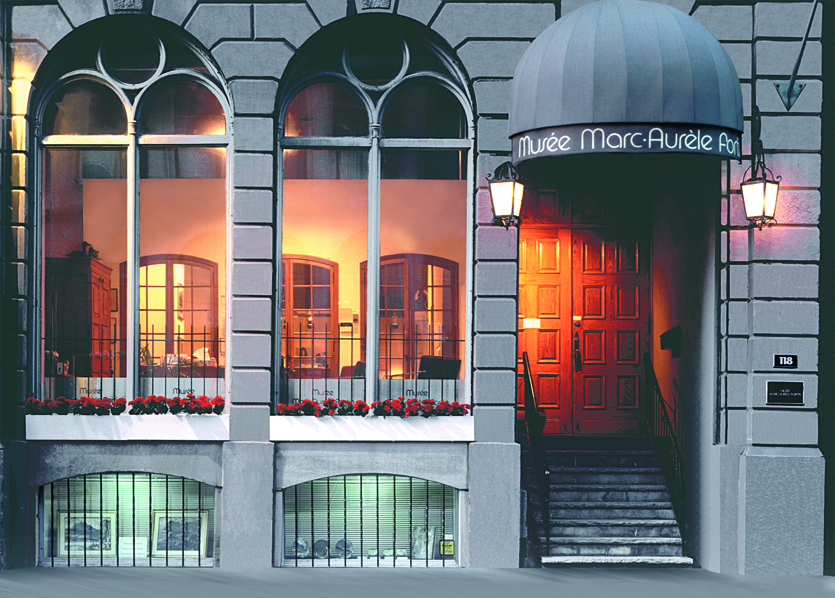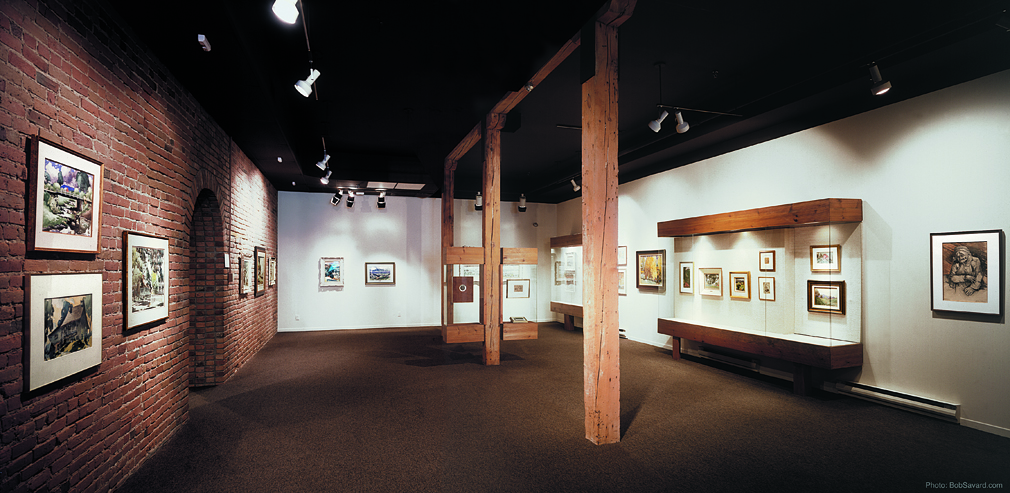The Marc-Aurèle Fortin Foundation was created in June 1974 under the impetus of businessman René Buisson. Its main mandate was to promote the work of this great landscape painter and pioneer of modern painting in Quebec. The Foundation’s objective was to create a museum entirely dedicated to the painter’s work, a project that René Buisson had already presented to the artist during his lifetime and that he therefore had in mind at least since the late 1960s.
With the help of the Honorable Jean Lapointe, performing artist and senator, Gabriel Lapointe, lawyer, and Jacqueline Sabourin, designer, the Foundation was at the origin of the opening of the Marc-Aurèle Fortin Museum in 1984. The Foundation’s activities were then put on hold in favour of those of the Museum. When in 2007, the Museum had to close its doors, a few years after the death of its founder, its administrators could not resign themselves to abandoning Marc-Aurèle Fortin and decided to give new life to the Foundation.
Founding Director of the Marc-Aurèle Fortin Museum
1984 -2002

René Buisson has always been interested in culture, education, arts and sports. In the 50’s, while running his commercial endeavours, René Buisson, a loyal and committed patron of the arts, showed his support for Quebec, Canadian and Aboriginal artists in various ways. It was at this time that he discovered the watercolors of Marc-Aurèle Fortin. His admiration for this artist will not cease to grow thereafter to the point where he will become one of the most important collectors of his works.
In 1962, René Buisson meets for the first time Marc-Aurèle Fortin in Sainte-Rose, where he lives in a precarious state of health, undergoing negligence and abuse from his agent and proxy. But unfortunately, the admirer cannot do anything about it.
During a subsequent meeting, in 1966, René Buisson had the good idea to record his interview with the painter. He then sought to document his life and his work. This interview as well as the fifteen or so others that he will make afterwards constitute a precious testimony of the artist on his career.
In 1967, fortuitous circumstances allowed René Buisson to free Fortin from the grip of his agent and proxy. He then took the initiative to place the artist, who had become almost blind and had lost his autonomy, in the safety of the Saint-Jean de Macamic Hospital in Abitibi, where he could benefit from the adequate care required. The collector thus contributed to the recovery of Marc-Aurèle Fortin’s dignity at the end of his life.
In 1974, René Buisson sets up the Marc-Aurèle Fortin Foundation. Ten years later, thanks to his unwavering determination, he succeeded in realizing the ambitious project he had imagined from his first meetings with the artist: on January 24, 1984, René Buisson and his collaborators inaugurated the Marc-Aurèle Fortin Museum in Old Montreal.In addition to directing the Museum, René Buisson pursues his mission by undertaking the writing of a book on the painter based on the numerous interviews he had conducted with him at the end of his life. This book entitled Marc-Aurèle Fortin, un maître inconnu was published in 1995.
A very accessible man, he enjoyed receiving visitors in his office at the Museum to talk about Fortin. Many people remember having warm discussions with this director who remained at the head of the Museum until his death in 2002.
René Buisson’s exceptional involvement with artists and the field of painting, combined with his management and leadership skills, have made him a leading figure in the Quebec art world. He received the insignia of member of the Order of Canada in 1991 for his contribution to the promotion of arts in Quebec.
Director of the Marc-Aurèle Fortin Museum
2002 -2007
After chairing the board of directors of the Marc-Aurèle Fortin Museum for several years, Jacqueline Sabourin succeeded René Buisson as director of the Museum from 2002 to 2007, until its closure, and remained as administrator – and later president – of the Marc-Aurèle Fortin Foundation for the Arts, until 2023. Thanks to her determination and her passion for visual art, she was of boundless support for the painter’s cause.
After having participated in the creation of the Museum and the laying out of its initial design, she remained a pillar of the Museum and Foundation team. She also was a member of the Canadian Art Acquisition Committee at the Montreal Museum of Fine Arts, and a design teacher at the Cégep du Vieux Montréal.
Her prestige in the field of interior design allowed her to achieve rapid academic and professional success, which in turn led her to host a television programme on the subject for several years.
Combining aesthetic skills with her organizational talents, delicate in her approach but powerful in her influence, she was an inspiration to her collaborators, students and friends.
A visionary, faithful to her commitment to the cause of the arts, she has, among other innovative projects, substantially collaborated in the continuity of a catalog raisonné on Fortin, initiated by her predecessor, and which continues to this day, in order to ensure the sustainability of Fortin’s work.
Under the aegis of the Foundation, the Marc-Aurèle Fortin Museum was inaugurated in January 1984 on St-Pierre Street in Old Montreal. It was housed in the former warehouse-stores of the Grey Nuns not far from the Old Port.

The Museum was made possible thanks to the help of inspired and devoted people that René Buisson was able to gather around him. Among them, let us name the lawyer, Gabriel Lapointe, who coordinated the project, the Honourable Jean Lapointe, who, thanks to his idea of a box of reproductions, allowed to raise enough funds to allow the institution to function and finally, Jacqueline Sabourin, designer, who assumed the responsibility of designing the recently renovated rooms of this former warehouse-store, which was advantageously made available to the organization thanks to a federal grant.
The Museum was directed by René Buisson until his death in 2002, then Jacqueline Sabourin took over and managed it until its closure in March 2007.
As a spin-off of the Foundation, the Museum’s main mission was to promote the work of Marc-Aurèle Fortin. More precisely, its mandate was to initiate and raise awareness of the public to the many aspects of this painter’s art, to catalogue his works and to centralize all documentation related to him, to make known the production of artists contemporary to Fortin in order to offer an overall vision of the socio-artistic context in which his production evolves as well as to promote the diffusion of Quebec and Canadian landscape art.
The Marc-Aurèle Fortin Museum, an institution financed mainly by private funds, thanks to generous donors, has shown resourcefulness and ingenuity in fulfilling its mandates with such dynamism over all of these years.

The Museum’s rooms were permanently equipped with the painter’s works. All styles and periods were represented. Numerous loans from private collections that varied over the years allowed the public to have access to lesser-known works. The Museum has also hosted or organized numerous temporary exhibitions that have shed new light on Fortin’s work or introduced other local artists. Examples include the exhibitions Jean-Paul Riopelle (1985), Maurice Lebel (1986), Alfred Laliberté: Les artistes de mon temps (1986), Jean-Philippe Dallaire (1986), Midi-Pyrénées : Le trait de génie. Goya, Ingres et Toulouse-Lautrec (1988), René Richard (1990), Fortin, peintre de Montréal (1992), T.X. Renaud, painter and church decorator (1993), Edmond-Joseph Massicotte (2000), Italian heritage (2004); Havre d’art, the bridge, the port, the painter (2005).
In parallel to these exhibitions, and thanks to the support of its faithful volunteers, the Museum has organized over the years a wide range of special events, lectures, art workshops, guided tours, concerts, etc. These activities have attracted a variety of audiences and introduced people to Fortin’s art in a different way.

Twenty-three years after its creation, the Marc-Aurèle Fortin Museum had to close its doors in March 2007. Deprived of operating subsidies (no recurring support was ever granted by governments), the institution was carried at arm’s length by a volunteer director and a handful of employees, who, supported by a board of directors and a few dedicated volunteers, struggled year after year to raise the funds necessary to balance its budget.
Over the course of its existence, the Museum had succeeded in assembling a collection of some one hundred works by Marc-Aurèle Fortin covering most of the artist’s pictorial techniques, genres and periods and including several major pieces such as Commencement d’orage sur Hochelaga, Arbre déraciné and Bœufs aux labours. The institution had also preserved an important archive collection composed of various objects that belonged to the painter, letters, audio recordings, photographs and other documents of great importance for research on his life and work. It was therefore imperative to safeguard this heritage and to ensure that it was disseminated as widely as possible.
The Marc-Aurèle Fortin Museum chose to turn to the Montreal Museum of Fine Arts. On March 31, 2007, his collection and archives were integrated into those of this century-old institution on Sherbrooke Street, which is now responsible for their conservation. The agreement also provides for a room from their permanent exhibition to be dedicated to Marc-Aurèle Fortin, thus ensuring the artist a good diffusion and a respectable place within the institution, which until then had only 3 of his works.
Promoting the work of Marc-Aurèle Fortin is the primary mission of the Foundation. Although the Musée Marc-Aurèle Fortin no longer exists, the Foundation wishes to continue to promote the development of knowledge about the artist and the dissemination of his works. In doing so, it also aims to keep his memory alive and to increase his recognition on a national and international scale.
The Foundation’s mandate is to support the creation of the artist’s catalogue raisonné. For several years already it has set in motion on this important worksite whose objective is, in short, to inventory and document the artist’s entire production. In doing so, it continues a project that was initiated at the turn of the year 2000 by the Musée Marc-Aurèle Fortin, a project that was itself already in line with the inventory work undertaken by René Buisson in the late 1960s.
In addition, the Foundation also wishes to raise awareness of Fortin’s important place in the history of art by supporting:
Finally, the Foundation also ensures that Marc-Aurèle Fortin’s copyrights are respected.
Are you interested in Fortin’s work? Do you also want to contribute to keeping the knowledge of this great Canadian landscape artist alive? The Foundation is asking for your donations. The Foundation is a charitable organization and can issue tax receipts.
To thank you for your donation, a product from our store will be offered to you free of charge according to the amount of your contribution:
Please feel free to contact us to discuss any possible contribution with us.
